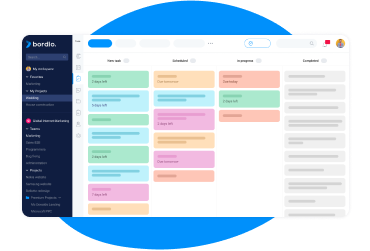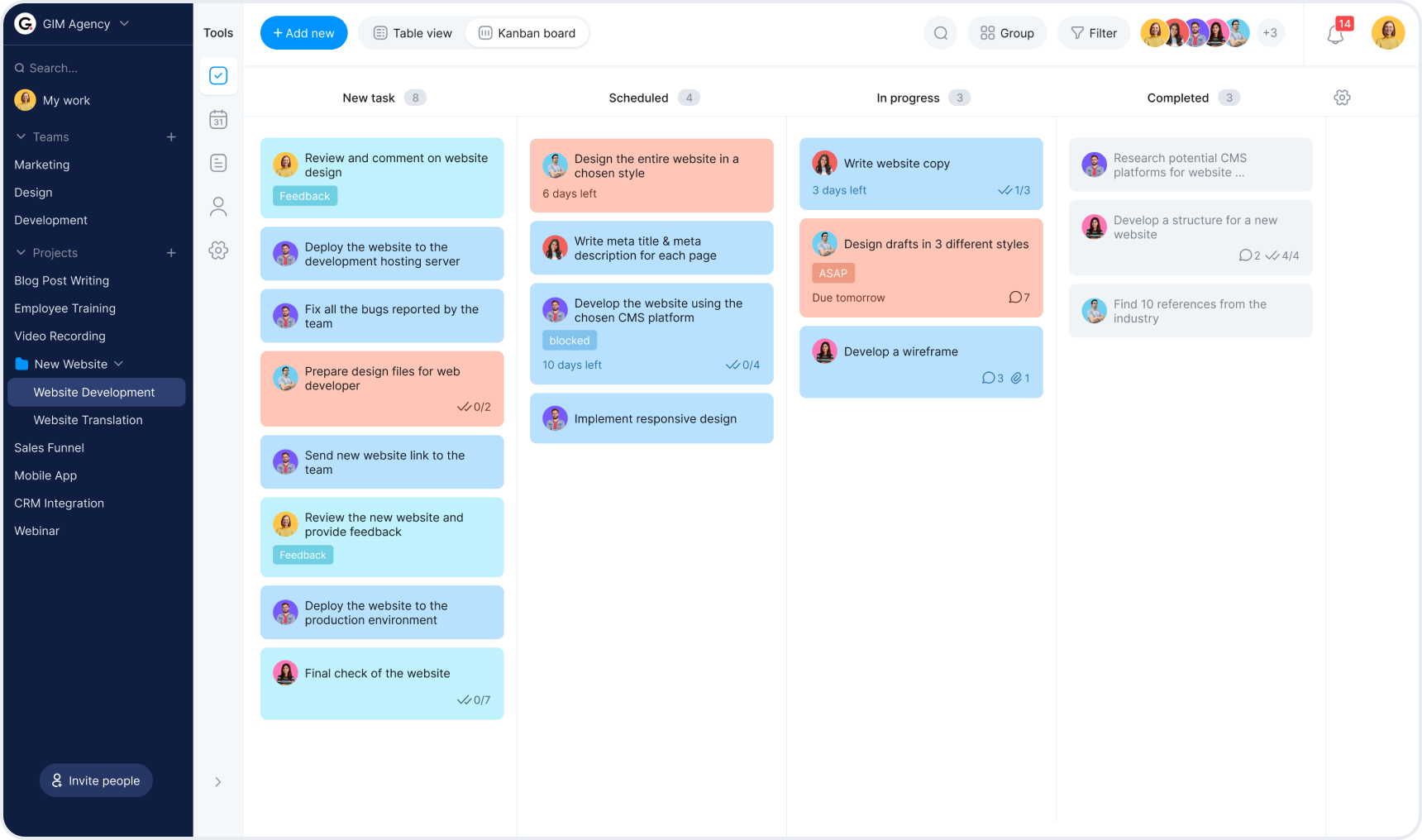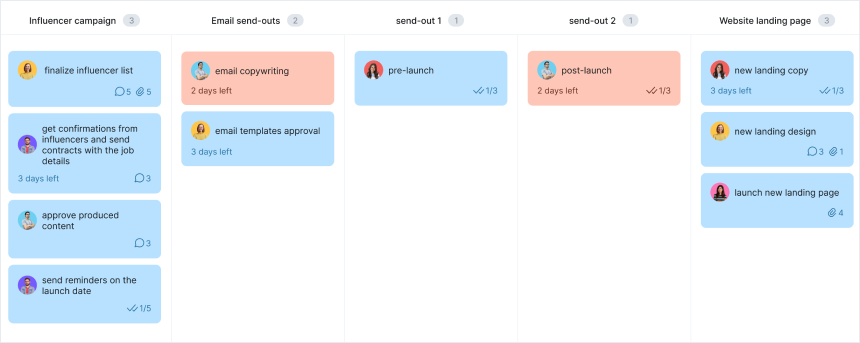Project management and the general goal achievement process require supportive tools, such as digital daily planners, and techniques that can enhance our processes and help us reach the final destination faster.
One of such tools that became a sensation of some kind is a Kanban board. In this article, we will talk about what a Kanban board is, where it originates from, and provide several examples of how it can be implemented into your personal or professional projects.
The backstory of the Kanban methodology
Before we dive deep into the nuances of Kanban boards, let’s find out a little bit more about the history of the Kanban term and its methodology.
Kanban is often called a project management methodology, just like Waterfall or PRINCE2 but it is really more like a philosophy or an approach to getting the work done. It helps manage the workload sustainably with process visualization, gamification, and eventual improvement through continuous learning.
Tip: Kanban mixes well with other methodologies, such as Agile and Scrum, so you can pair it with something else for more project management structure.
The term “Kanban” originates from Japanese where it stands for “billboard” and the Kanban board, the most popular element of Kanban, resembles the billboard where all tasks and their statuses are displayed.
The Kanban method was originally introduced in a Toyota factory in an attempt to optimize and streamline their manufacturing and product development process. Very quickly it was adopted by the technology industry and became a standard and widely enjoyed tool of the software development teams.
Kanban is rather flexible and encourages teams to play with its principles and make it work for their particular case. However, there is one aspect that Kanban is pretty strict about – work-in-progress limits. Kanban advocates for keeping the work process smaller and finishing tasks before moving on to new ones. That way, the workflow efficiency is maintained, and different team members don’t find themselves in situations where they have 20 tasks in their weekly planners that they’ve started and none completed.
You can read more about the Kanban method and its backstory in our Kanban guide.
Kanban principles
There are 4 main Kanban principles that touch on different aspects of the working process and complement one another nicely:
- Start with what you are doing now.
- Agree to pursue incremental, evolutionary change.
- Respect current roles, responsibilities, and job titles.
- Encourage acts of leadership at all levels.
Kanban practices
There are also 6 key practices that Kanban follows that are paired with the 4 main principles:
- Visualize the flow of work.
- Limit work-in-progress.
- Manage the flow.
- Make process policies explicit.
- Implement feedback loops.
- Improve collaboratively, and evolve experimentally.
The Kanban system works best if all practices and principles are accepted and used in conjunction. However, as a rather laid-back philosophy, Kanban recommends taking it slow and not pushing for all new rules and guidelines to be implemented immediately all of a sudden. In fact, it encourages a gentle switch that remains sustainable and allows people to really adapt to it.
What does a basic Kanban board consist of?
The first Kanban boards were introduced when using your PC and smartphone for everything wasn’t a thing, so people had to work with a physical Kanban board if they wanted to utilize the tool. Nowadays, the situation is drastically different, and many project managers prefer a digital Kanban board version because it allows 24/7 access from anywhere.
By the way, Scrum boards are pretty similar to Kanban boards but have a few different rules. They can be a good alternative if you’re unsure about Kanban’s version of the board. Check our detailed Scrum boards guide for more detail.
Tip: Use boards together with a powerful online calendar planner by Bordio. It’s free and you can schedule both tasks and events in one place, dump all unscheduled tasks and ideas to the Waiting list, and track your daily workload.
Still, if the project team is all in one place, physical boards are a nice alternative to online Kanban boards as they can be interacted with physically, and that adds a bit more fun into the often stressful project management process.
Kanban boards are rather straightforward, so a basic Kanban board structure consists of a few elements only: the board itself, cards, and columns.
Board is divided into columns which can differ depending on the department (e.g., a sales Kanban board will have different goals and, therefore, the team task list in a marketing project would focus on campaign activities.) or the company’s policy.
Yet, the basic columns that you’ll see most of the time are:
- Backlog
- To- do
- Work-in-progress (w–i-p)
- Done
Each task that the project team defines has a dedicated card. The cards are then moved from left to right based on their status. With an online Kanban board, you would move them with a click of the mouse, and a physical board would require actually coming up to the board to do it, adding an extra sense of accomplishment.
Kanban board examples
Kanban boards are really universal. They can be used in various fields and teams, and the tool is really flexible and still works well if adaptations and tweaks are necessary.
Below are several Kanban board examples of what a Kanban board could look like for IT operations, software development, sales, marketing, and task management. Please feel free to use them as a Kanban board template for your own projects.
Tip: Project managers wear many hats and have countless responsibilities, and they can use multiple boards for their different projects or even roles within one project.
Kanban board example for IT operations
Here is an example of what a Kanban board could look like for an IT department.
Columns with card ideas
- Backlog: security compliance review; fax and printer configuration.
- Work in progress: upgrade cloud storage capacity; the migration from VMware to HyperV.
- Ready for review: new sandbox setup; issue with remote access; research backup vendors.
- Deploy: new VPN configuration; system backup.
- Done: h/w servers update; calendar not creating new events.
Kanban board example for software development
Now let’s see what a Kanban board could look like for development teams.
Columns with card ideas
- New items: server CPU usage not optimized.
- Priority 1: search console doesn’t work.
- Priority 2: add the description field in event details.
- In progress: new interface design.
- Testing: email integration.
- Ready: end-to-end encryption.
Kanban board example for sales
Sales Kanban boards would typically be focused on closing deals and working with leads. So, here is what a sales pipeline Kanban board could look like.
Columns with card ideas
- Leads: email@email.com; email11@email.com.
- Intro call done: John Doe
- Demo testing
- Technical stage complete: Jane Doe
- Contract negotiations
- Closed Won: Betty’s cupcakes; NBA Fan club Boston
- Closed Lost: ABC Enterprises
Kanban board example for marketing
In our marketing Kanban board example, each column represents a sub-project in marketing with different activities assigned to it.
Columns with card ideas
The example project is a new product launch with several sub-projects that the marketing team is working on simultaneously.
- Influencer campaign: finalize influencer list; get confirmations from influencers and send contracts with the job details; approve produced content; send reminders on the launch date.
- Email send-outs: email copywriting; email templates approval; send-out 1: pre-launch; send-out 2: post-launch.
- Website landing page: new landing copy; new landing design; launch new landing page.
Kanban board example for task management
Last but not least in our Kanban board examples section is the board for task management which contains both personal and work-related tasks. Such a board can be used by anyone and anywhere. And of course, you can just have a personal Kanban board and not mix it with your work life if you want a bit more separation.
Columns with card ideas
- Top priority: enroll for the C++ course; vaccinate the dog; update travel ID before vacation.
- To-do: clean the garage; email Nancy; start English course.
- Waiting on somebody: approve bathroom design; review quarterly report.
- Doing now: annual performance review; taxes for 2021; Australian visa application.
- Done: new frontend A/B testing; meeting with investors; Investor PPT slides.
Kanban board benefits for projects and general workflow
Before we sign off, let’s touch on the key benefits of Kanban boards once again.
Kanban boards increase work efficiency through tools’ work visibility and integration with an employee productivity tracker. As a very agile project management tool, Kanban gently showcases the current state of things and pushes us towards better efficiency. If you see that there are just two tasks with “in progress” status but 12 tasks that are not even started yet, you are almost guaranteed to get to it faster to see the change on the board.
Kanban boards reduce downtime and delays with the help of transparency – literally everything that needs to be done is on the board! There’s no way those tasks can hide.
Kanban boards provide flexibility in working on tasks. They are all listed as cards in one place and can be picked up on the go and added to the individual online to-do list by anyone with the right skills or enough capacity.
Digital Kanban boards can be accessed by the entire team anytime and anywhere, making them perfect for hybrid or remote work especially when paired with a team task tracker for enhanced coordination.
Call us biassed, but we are huge fans of Kanban boards and can confidently recommend it to everyone. They are commonly used by engineering teams and software developers but would be a perfect fit for any project portfolio management job.









